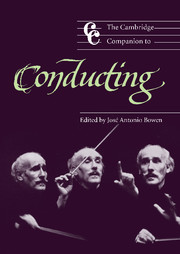7 - The orchestra speaks
from Part I - Practice
Published online by Cambridge University Press: 28 September 2011
Summary
The day has finally come. You are about to have your first encounter with a “major orchestra.” The first rehearsal is at ten a.m. You arrive at the hall in good time. The orchestra manager greets you cordially and says he will introduce you to the orchestra. It is 9.59. You stand in the wings. The orchestra is tuning. Now all is quiet. The manager escorts you on to the stage, and gives you a nice introduction. There is a smattering of polite applause. You mount the podium, and say how happy and honored you are to be there. You are ready to begin. The first work to be rehearsed is the Beethoven Consecration of the House Overture, and the players have been apprised of this. (You like those nice big opening chords!) You give a good hefty downbeat and … nothing happens! In a split second, you say to yourself, “What's wrong?!” Then you hear it; the chord is late. But why? You start the next chord and the same thing happens. So it goes, through the next three chords. Almost inadvertently, the orchestra is sending you two messages: (1)We want to be led. (2) Not one of us will play until we are sure that everybody else is playing. An orchestra – especially a major orchestra, with a large budget – develops an instinct as to when to play. They know that their jobs are on the line with every note. It is uncanny, but it works. They all play exactly together. To you, the young conductor, they are late. To them, they are right on time.
- Type
- Chapter
- Information
- The Cambridge Companion to Conducting , pp. 79 - 90Publisher: Cambridge University PressPrint publication year: 2003
- 2
- Cited by

